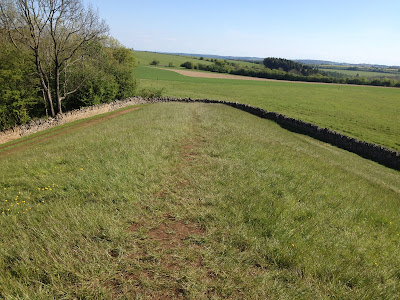Belas Knap is
a long barrow near Winchcombe in Gloucestershire. It was built in the early
Neolithic period and is of similar style to dozens of other barrows found
across the Cotswolds and the Severn valley.
The barrow is
situated on a wide, rolling hillside, with a wide view in three directions and
a steep, wooded scarp dropping sharply on the eastern side. This was probably wooded
in the Neolithic period and so would have obscured the only prominent view of
the barrow. From all other directions, the barrow quickly blends into the
ground. Like Wayland's Smithy long barrow, Belas Knap was not intended to be a
visible statement, but conversely the barrow itself has a sweeping view of the
landscape. They seem to be about blending with the earth, returning the
ancestors and their skills to the earth, as well as legitimising their continuing
presence on this tract of land. They reflect heritage and belonging.
Belas Knap
from the east.
View south from
the barrow.
The barrow is
aligned to the north. This is unusual: most long barrows face roughly east. Four
burial chambers were set into its length and the main forecourt with its stone façade
was actually a false entrance. It’s believed the chambers were built separately
as individual burial mounds, then later incorporated into a huge barrow. Many
barrows including Wayland’s Smithy were originally smaller structures which
were extended into huge mounds a century or two later. Even earlier than the chambers
was a circular arrangement of stones lying near the centre of the current
mound.
The barrow was
crudely excavated in the 19th century and restored to its current
condition in the 1920s. It was originally 60m long and 25m wide but its edges
have now been trimmed due to erosion, agriculture and excavation. Thirty eight
bodies were found, dating from 3700BC-3600BC.
Behind the
slabs of the false entrance were the bones of one man and five children, along
with flints and horse and pig bones. The western side chamber, lined with
sarsens and drystone walling, contained fourteen bodies including a woman with
fatal head injuries. The southern chamber, now almost entirely destroyed,
contained one body. The south-eastern chamber, which is much lower and has to
be entered on one’s belly, contained four bodies. The north-eastern chamber
which is lined with sarsens contained twelve bodies.
The chambers
were repeatedly visited and opened and sealed, probably used for rites such as
marriage, blessing the land and blessing births as well as for burial. Then, like
many long barrows, the chambers were eventually sealed for good. This often
seems to coincide with the arrival of bronze in Britain around 2500BC.
The north-east
chamber.
Barrows were
often respected for millennia after their closure, although their stones crumbled
and collapsed and trees and shrubs obscured them. Belas Knap means ‘beautiful
hilltop’. As this seems to refer to the barrow itself rather than the hillside,
it is perhaps a name of uneasy respect given by later, more superstitious
people to a haunted and feared place. Many ancient sites were avoided as haunts
of fairies or dwarfs, later still the work of the devil. This may derive from
people unwittingly uncovering the bones of long-dead people, or perhaps it is a
long-remembered folk memory of the fearful rites once conducted here.





No comments:
Post a Comment